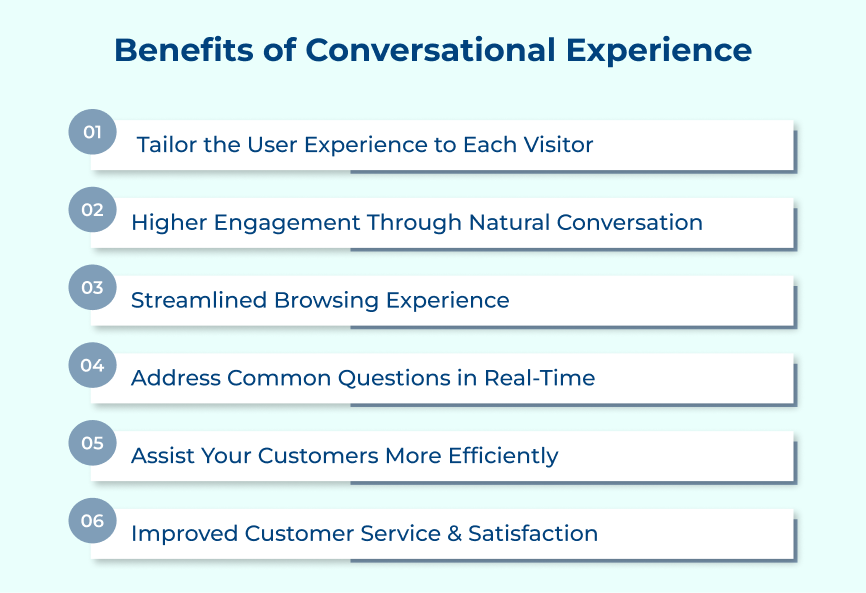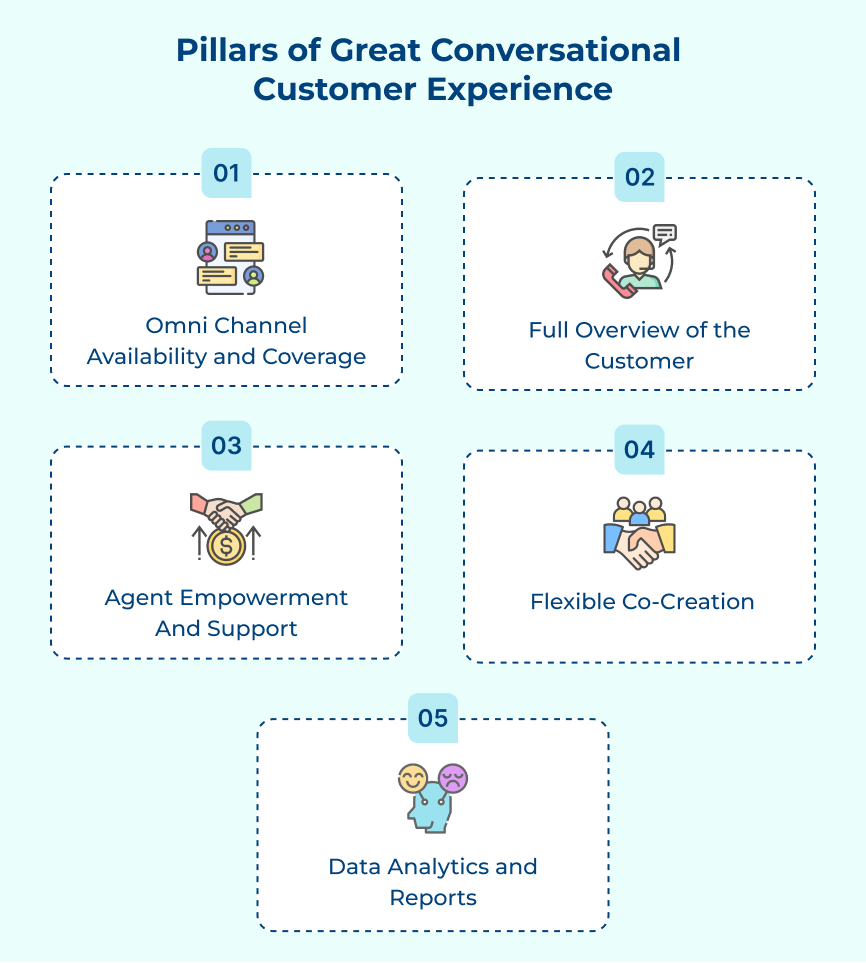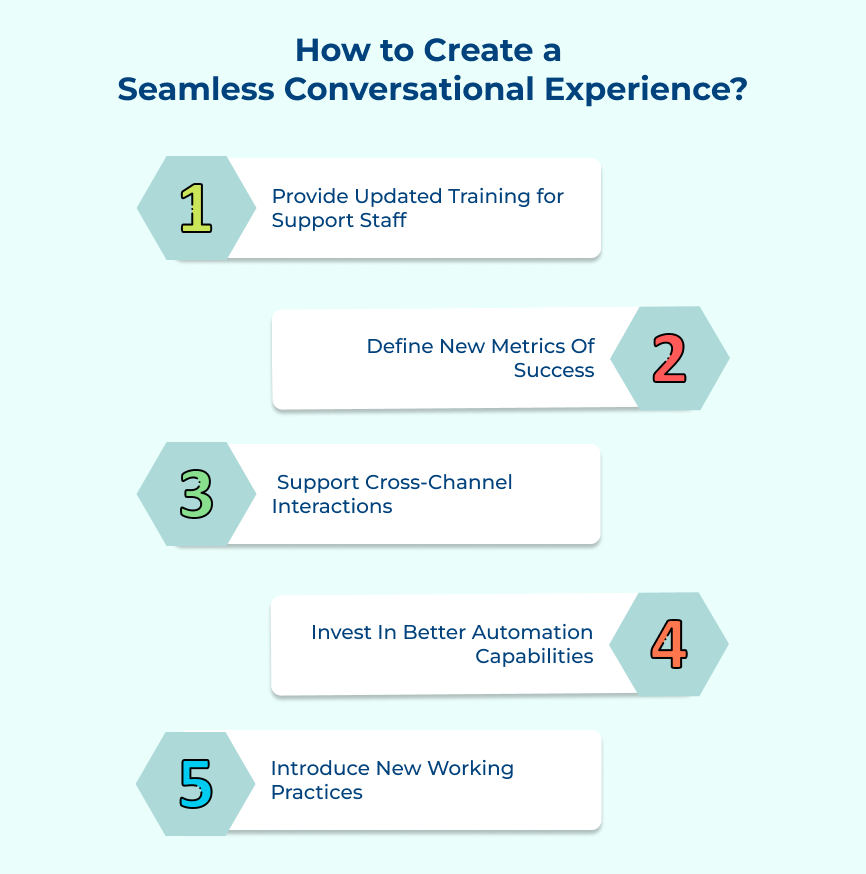Pillar 1: Omnichannel Availability and Coverage
Customers expect seamless and convenient interactions with businesses. One vital pillar that contributes to a great AI conversational experience is omnichannel availability and coverage. It focuses on ensuring that businesses are present across multiple channels and platforms to engage with customers effectively. The goal is to provide customers with a consistent and cohesive experience, regardless of the channel they choose to interact with a business.
Imagine a customer who starts a conversation with a business through their website’s live chat feature. They later decide to continue the conversation on social media. The omnichannel availability and coverage help businesses ensure the conversation seamlessly transitions to the preferred channel without any disruption. It leads to a more satisfying customer experience.
Pro tips:
- Integrate all channels: Ensure that all channels are seamlessly connected, allowing for a smooth transition between platforms. The integration will enable customers to continue their conversations seamlessly without any repetition or loss of context.
- Personalize the experience: Leverage customer data and insights to provide personalized experiences across all channels. Tailor messages and responses to each customer’s preferences, enhancing the conversational experience standard.
Pillar 2: Full Overview of the Customer
The conversation can take place face-to-face or through digital channels, but having a full overview of the customer is important for creating a great conversational experience. The pillar focuses on understanding the customer’s preferences, interests and needs to personalize the conversation. The goal of this pillar is to gather as much information about the customer as possible, establishing a comprehensive understanding of their background, interests and previous interactions.
Imagine a customer service chatbot that is programmed to gather information about the customer’s previous interactions and preferences. The chatbot can then provide personalized recommendations, address specific concerns and offer relevant solutions. Such a level of personalization creates a more engaging and satisfying conversation for the customer.
Pro tips:
- Collect customer feedback: Regularly seek feedback from customers to understand their experience and gather insights on their expectations. Feedback can be obtained through surveys, interviews, or even social media platforms.
- Continuously update customer profiles: Regularly update customer profiles with new information and track their engagement across different channels. It will ensure a comprehensive and up-to-date overview of each customer, enabling businesses to provide personalized conversations consistently.
Pillar 3: Agent Empowerment and Support
The crucial aspects that are often overlooked in providing a great conversational experience are agent empowerment and support. While the focus is often on the customer, neglecting the support and tools necessary for agents can ultimately impact the quality of interactions. The goal of this pillar is to equip agents with the resources, training, and motivation they need to excel.
Companies can invest in comprehensive training programs that teach agents not only about the company’s solutions but also about effective problem-solving techniques. It allows agents to deliver accurate and relevant information to customers while addressing their concerns efficiently.
Pro tips:
- Continuous training and development: Offer ongoing training opportunities to keep agents updated with the latest industry trends and best practices. It empowers them to handle diverse customer inquiries and provide timely solutions.
- Provide advanced tools and technology: Equip agents with user-friendly customer relationship management (CRM) software, chatbots and other technological tools that streamline workflows.
Pillar 4: Flexible Co-creation
The flexible co-creation pillar focuses on the collaborative nature of conversations, allowing users to have an active role in shaping the outcome. A strong chatbot strategy empowers users by providing them with a sense of control and involvement in the conversation. It enhances engagement and creates a more personalized experience by encouraging users to contribute actively.
A great example of flexible co-creation can be seen in chatbots or virtual assistants that allow users to customize their preferences. A weather bot may ask a user about their preferred temperature units or the city they would like to receive forecasts. The conversation becomes more tailored to their needs and preferences by giving users the option to personalize their experience.
Pro tips:
- Provide options and flexibility: Offer users a range of choices to customize their experience. Give users control to make them feel more invested in the conversation.
- Enable user-generated content: Encourage users to contribute their ideas, opinions, or suggestions. It can be done by asking open-ended questions or inviting them to share their experiences.
Pillar 5: Data Analytics and Reports
Data analytics and reports serve as a critical pillar in AI conversational experience. The pillar focuses on harnessing the power of data to enhance the quality of interactions and provide valuable insights for future improvements. Businesses can gain a deeper understanding of their customers, identify trends, and make informed decisions by analyzing data collected from conversations.
Imagine a company operating a customer support chatbot that may analyze data to identify frequently asked questions and common issues. Understanding the patterns allows businesses to optimize the chatbot’s responses and improve problem-solving capabilities. It eventually provides a more efficient and effective customer support system.
Pro tips:
- Set clear objectives: Clearly define what you aim to discover or achieve through data analysis. It allows businesses to focus on extracting meaningful insights that align with your business objectives.
- Choose relevant metrics: Select key metrics and indicators that align with the conversational goals. It could include response times, customer satisfaction ratings or conversation length.
Conversational Customer Experience Use Cases
Exploring the conversational customer experience use cases highlights how businesses can effectively deliver personalized, efficient and impactful customer experiences.















